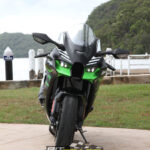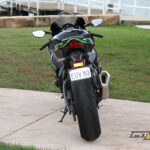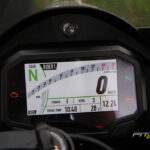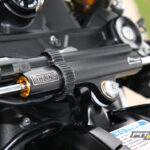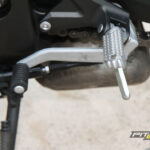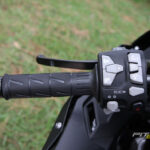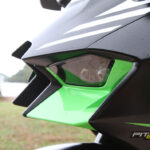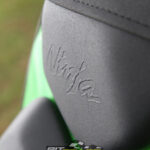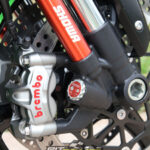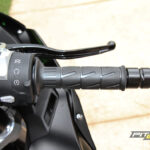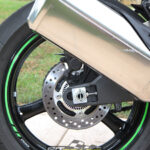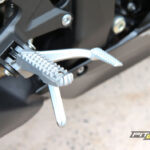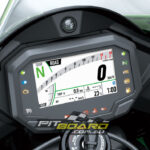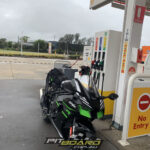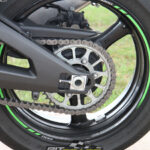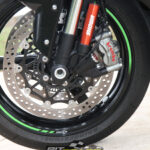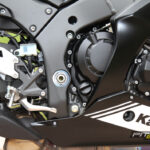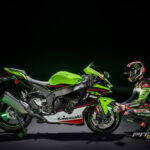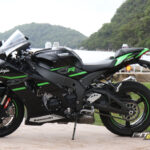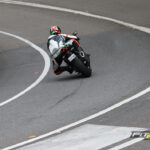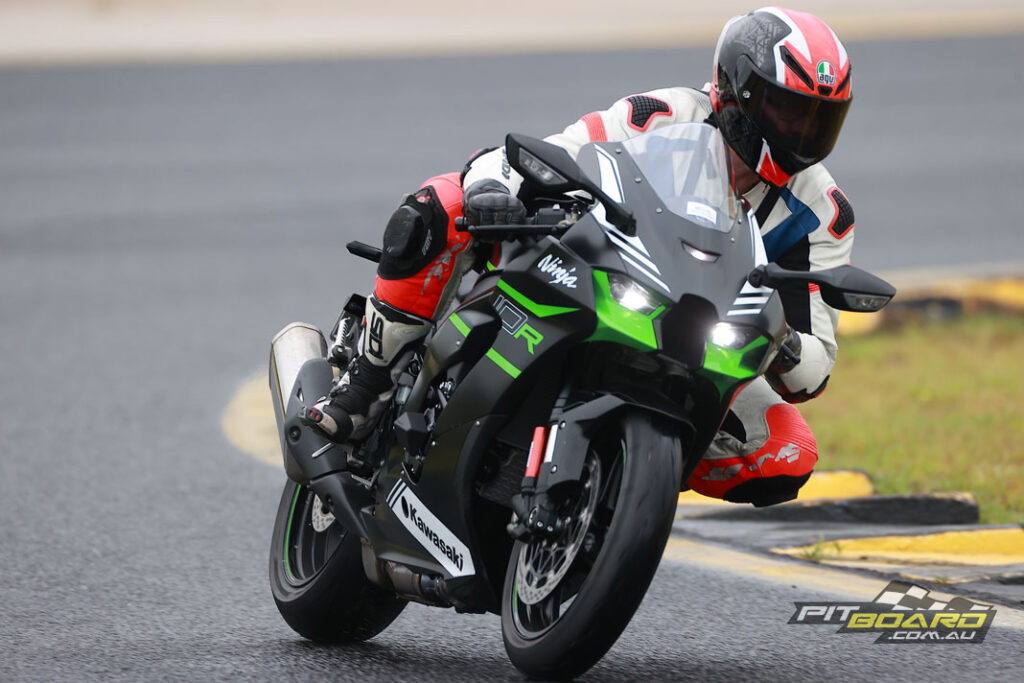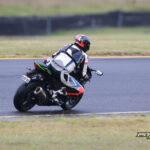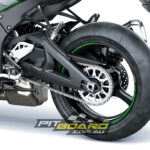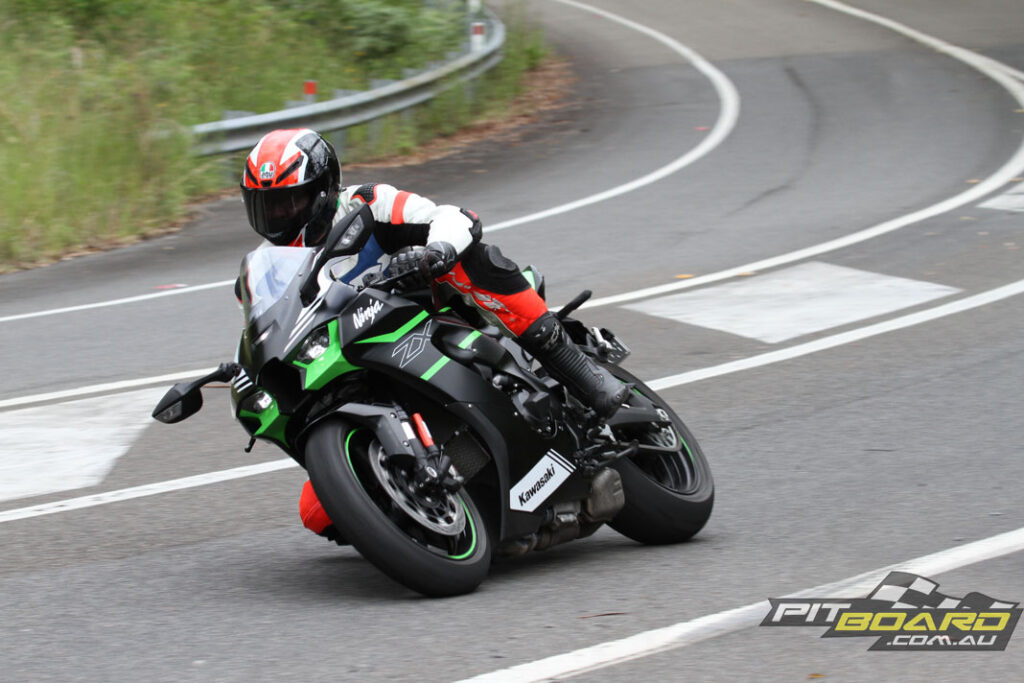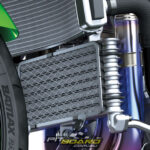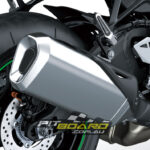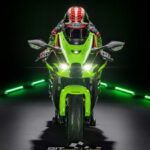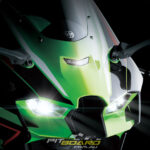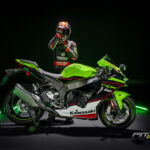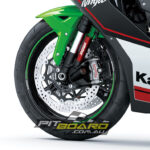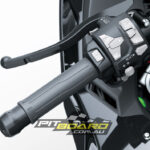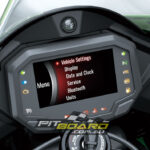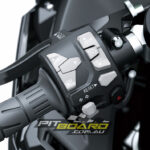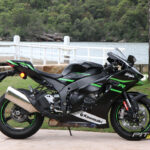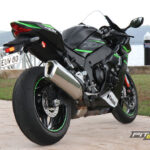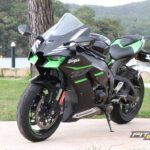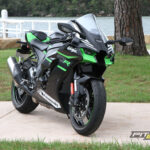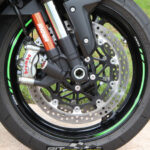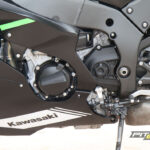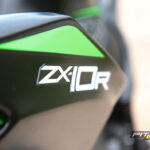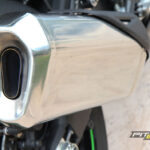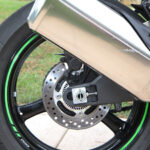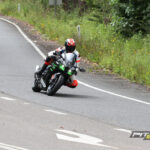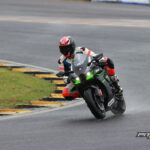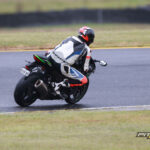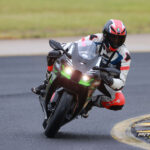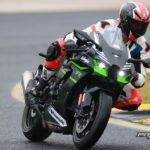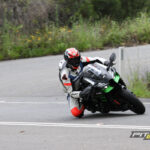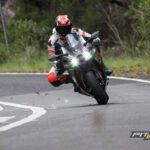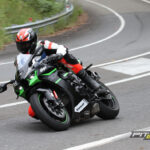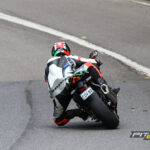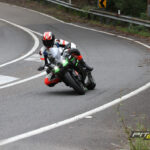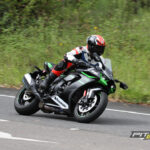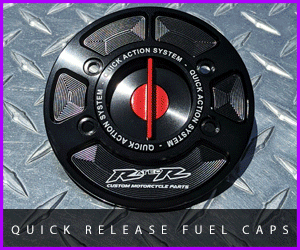In 2016 KMA hosted the World’s First press test of the new ZX-10R. Back then we said it was the closest Kwaka to a real World Superbike. The ZX-10R SE came next and we loved that. Now, in 2021, Kawasaki have done the impossible and further improved the mighty Ninja ZX-10R…
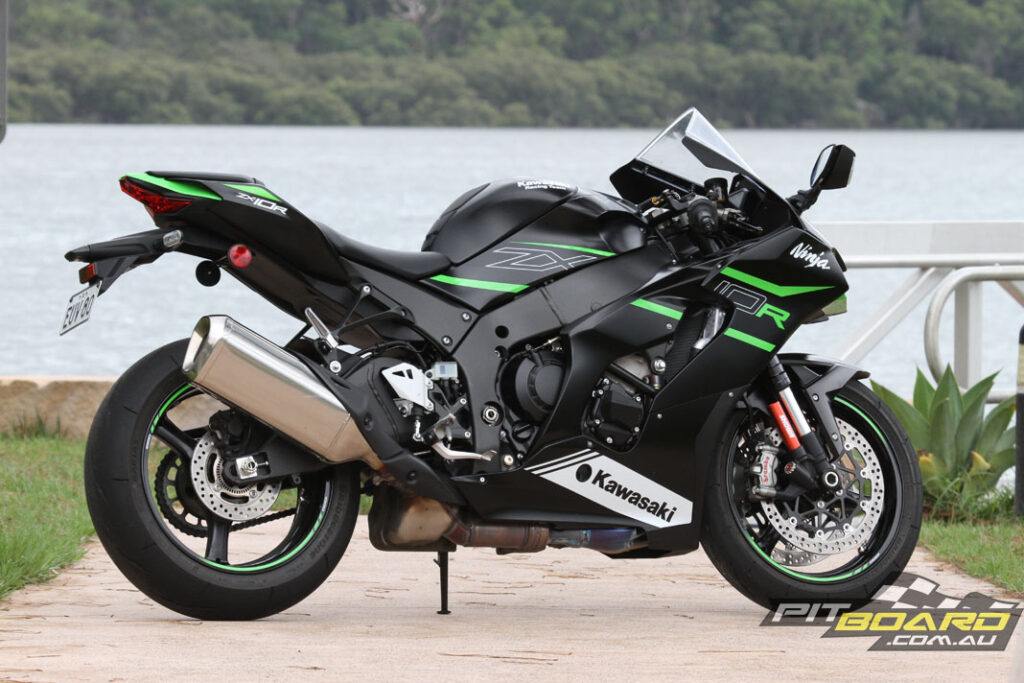
Back in 2016 when I rode the all-new heavily revised ZX-10R at the World Debut at Wakefield Park, I was completely blown away by the improvements to the machine. Having tested every version of the 10R since the first one, and had multiple long-term ZX-10R projects, I was pleased to find the aggression had gone and the chassis was balanced and, most importantly, it steered well.
Check out our other Bike Reviews here…
I then road tested that bike followed two years later by my all-time favourite ZX-10R, the limited edition ZX-10R SE, which had electronic suspension and was the ultimate road going 1000cc superbike, with 200hp, a plush ride over bumps but firm and razor-sharp with the press of a button, ready for a track day. So, when I got the call to grab the latest 10R, the further revised 2021 model, I could not wait to find out what it was going to be like on road and track…
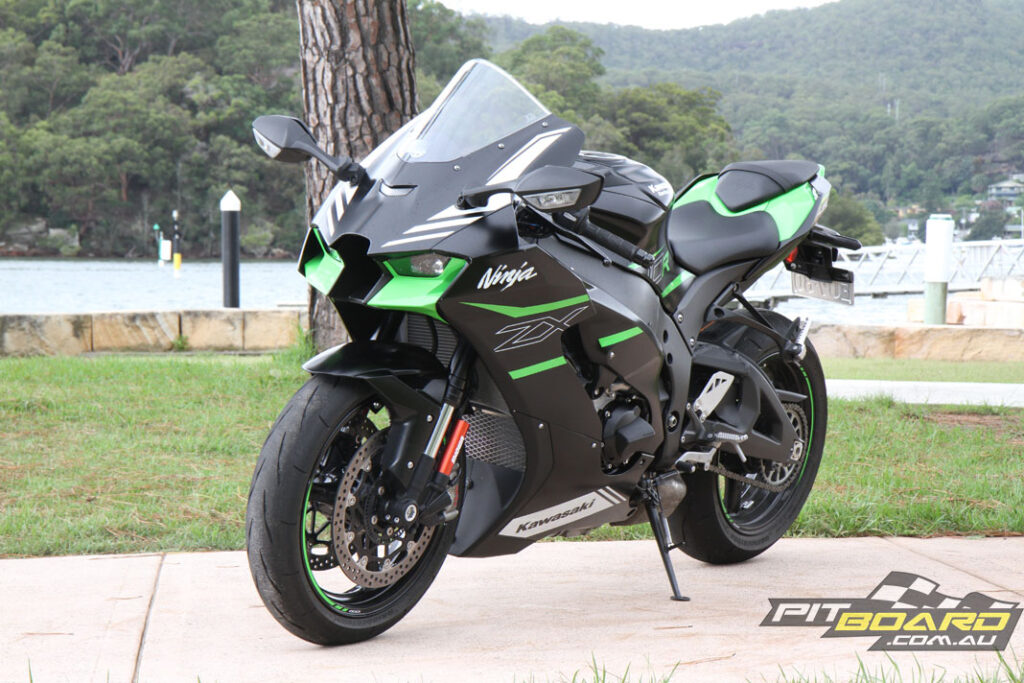
You can click the link below to read about all of the changes to the bike for this year, I won’t go into it again. In short, there are refinements to the electronics, engine, geometry, suspension, ergonomics and the obvious one, the aero package/styling… I have to admit, I reckon it looks amazing.
Looking at the weather forecast, I knew I was in for a soaking during the fortnight I had the ZX-10R in the garage… This stunning, brand new Ninja without as much as a speck of dust on it was about to become filthy. It was forecast to rain most of the fortnight, so the Rain mode was going to get a workout – and it sure as hell did… On the street and the circuit.
Walking around and taking a good look over a new bike is always the first thing I do once I get it to BikeReview HQ. Checking out the ZX-10R, I was undecided as to whether or not it beats the SE in looks or not. So I looked back on my old images and decided the new one definitely gets the nod, particularly with the TFT display and the new front-end. It looks a lot better in the flesh than images, too, and over the test period would prove to be a magnet wherever I parked up…
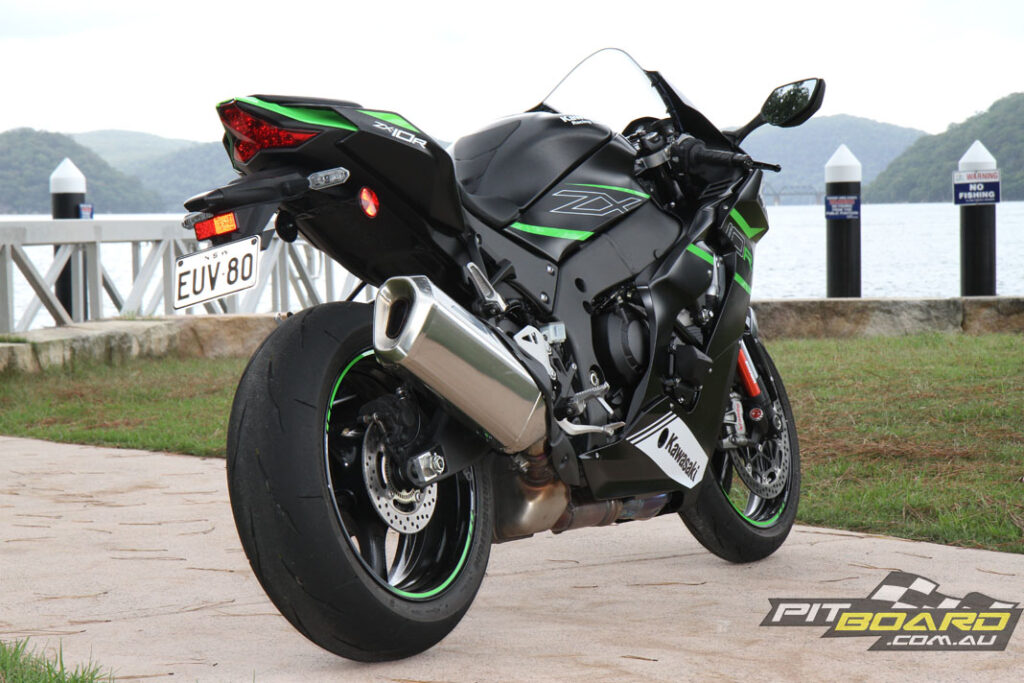
THE RIDE
Sitting on the bike for the first time, the changes to the rider triangle are immediately noticeable to me. This feels more like a superbike than any of the previous ZX-10R models. Well, perhaps not more than the Tom Sykes factory WorldSBK I rode in 2011 at Portimao, but close! With a tall rear section of the race-firm seat, a longer reach forward to lower and flatter ‘bars, plus even taller footpegs than the already tall ones of the outgoing model, the new ZX-10R is all about the track, no compromises…
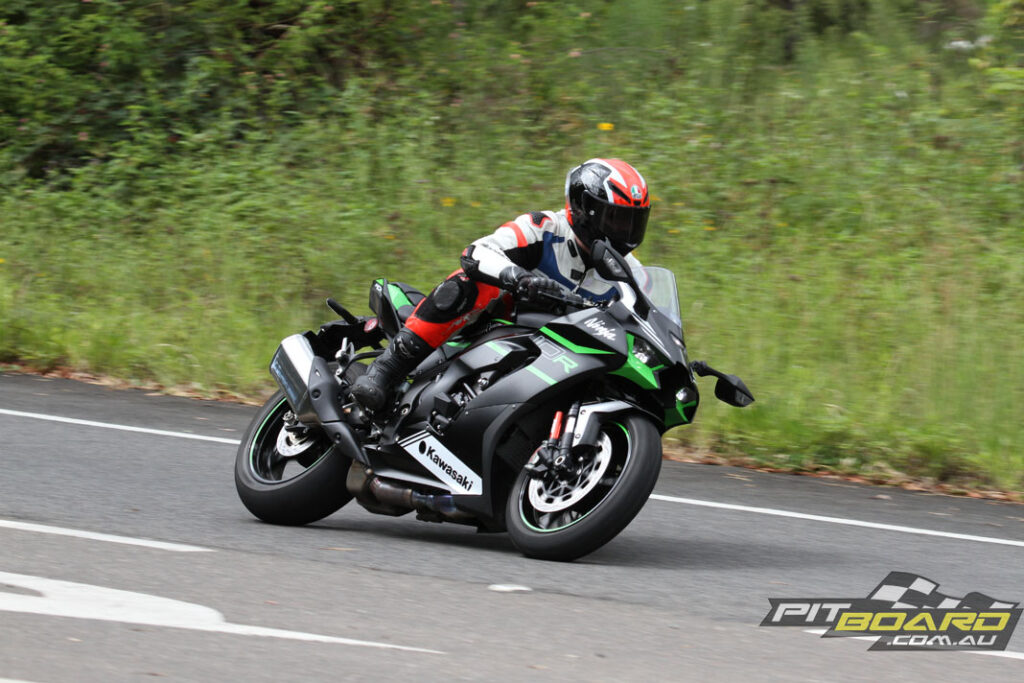
It certainly feels more like my own race bikes did over the years, almost more like a nakedbike with flat, low and wide ‘bars and a tall ride height. I already know this will work on track and that it will be a compromise to the road experience for some riders. For me, I like the familiarity. I’m just concerned about the legroom as I prepare to head off for my first ride on the bike – a trip to catch up with Streetbike and Performance Cycles founder and Street Machine legend, now Retrobike (one of our previous titles) editor, Geoff ‘Seddo’ Seddon, who I first started chasing along the Old Road when I was just 16! What will he think of such electrickery?
I fire the beast into life (it takes about five cranks, this doesn’t improve over the test), and it settles into a low, rough idle with a few exhaust leaks until the system heats up and expands. It reminds me of a real race exhaust system built to exact tolerances. As the engine warms, I familiarise myself with the new TFT dash and the switches, which are standard Kawasaki premium model in design and function. I select Road mode, reset trip B, adjust the mirrors and brake (clutch is not adjustable) and head off…
My first impression of the ZX-10R as I head down the road is that it is very radical in seating position for the street. Being taller, the ‘bars are a long reach, so where the ergonomics are designed to promote race crouch, for me, my arms are dead straight, because my back is long. If I bend my elbows and move to a race crouch, I can’t see forward or around as much as I would like to for urban riding. I also need to crouch down just to see out of the mirrors. The new footpeg height is tight but OK, I would not want it any closer though between the footpegs and the seat. I like the wide ‘bars.
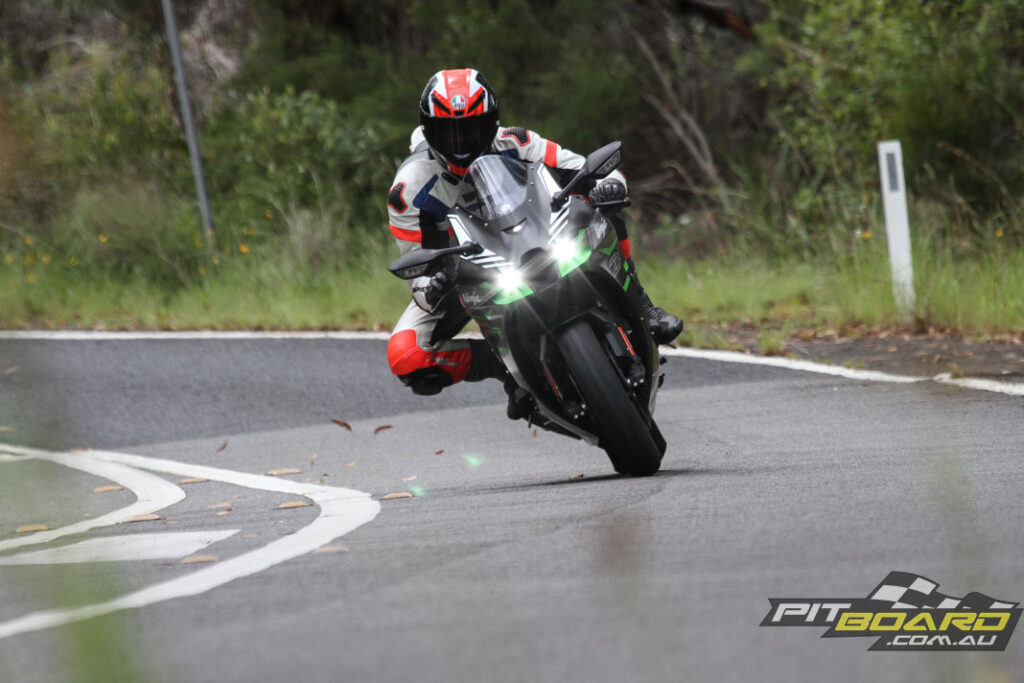
Like it was previously, the engine is as smooth as silk, a proper inline-four. In Road mode the throttle is gentle on initial opening and below 4000rpm the engine is nice and docile in the traffic. The clutch feels heavier than it did previously, which is strange, but it hardly get used. The KQS, which is only supposed to work above 2500rpm, works as low as 1000rpm, up or down. The engine will pull from 1000rpm, no problem, with a step up from 4k and another from 6k, and is a pleasure in town.
Of course, gearing is tall, not too tall though, so first and second gears are all I use, with a short-shift to third at times. The temperature is well regulated and there is no unpleasant heat around my legs. Braking in town is a one finger task on the front lever, or a decent push on the rear brake. The rear brake ratio is another indication of the track focus and one I prefer, as I’m a clumsy but heavy user of rear brake on the racetrack and I always lock up sensitive rear brakes when racing or at track days. I was one of those riders that used to bleed air bubbles into my rear brake system, or add huge rubber bands to the lever, to prevent the bike going sideways into hairpins!
I’m soon on the M1 motorway. I could have taken the twisty road but I really want to try the Cruise Control. So easy to use, the ECC is armed with a button on the left switch block and then alongside that there is the + and – speed, Select/Reset buttons. At 110km/h the ZX-10R is spinning at just 4500rpm and virtually vibe free, just a tingle through the ‘bars and ‘pegs as I relax on the Ninja.
The River Mark and neat graphics all add to the ownership experience…
Up to 120km/h, that buzz increases and can cause some numbness in the hands (as I found out on a few of the longer trips I did). The mirrors are clear, unlike the 2016 model mirrors at speed. When increasing or decreasing the cruise speed via the buttons, it takes a good few seconds for the 10R to react. Still, a great feature and one I use a lot during the test.
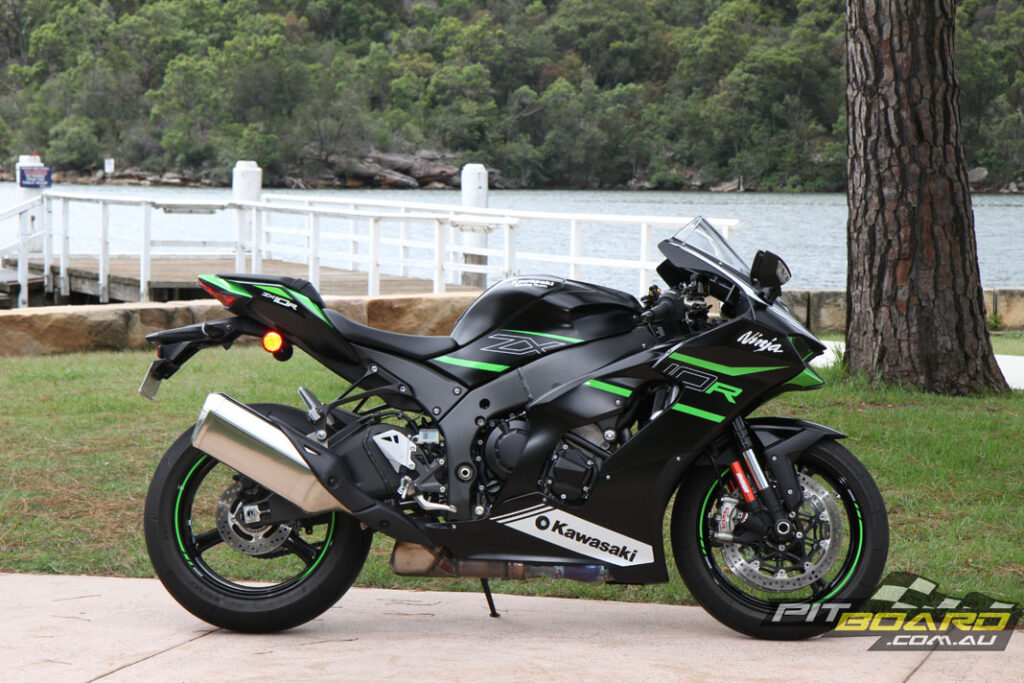
I arrive and Seddo and I discuss old school versus new. His famous red 900SS is still in his shed. I remember it on the cover of Performance Streetbike when I was still in school… I try to convince him that the new bikes and electronics are, in fact, awesome and fun. He shakes his head. When you come from old school air and oil-cooled long-stroke grunt, these new bikes are like electric vehicles, I guess.
I head home on the tourist route. Fast, bumpy and familiar. With the outstanding grip from the Bridgestone RS11 Street Race tyres on hand I’m able to push the limits, even with damp patches of tarmac lurking in the shadows. In Sport mode, the 10R comes alive, with a slightly more direct feel at the throttle from around 4000rpm and a heap on tap from six grand.
The riding position is making sense as the speed increases and the lean angle indicator starts going past 50º in the corners. The forks are as good as I remember them being, as close to the best I’ve experienced on the road. Bumps are almost not felt, not even a twitch through the ‘bars, yet there is firm support on the brakes.
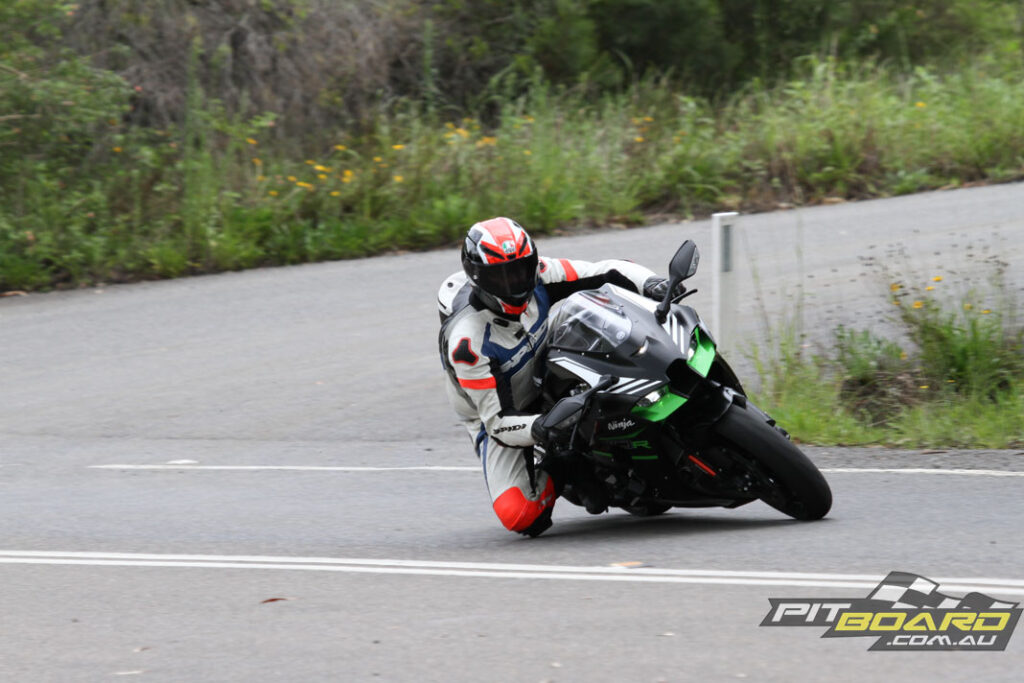
Steering is noticeably sharper on initial turn-in, particularly off the brakes where the previous model liked the front loaded up for a quick turn. The new riding position, revised fork settings and rear spring change has made the 10R racier into corners. It’s fantastic for last-second line changing, even deep into a committed turn, while remaining stable and communicative. You would not even know the steering damper was working hard, there is no vagueness in the front, and the mid-corner composure, even at full lean and over bumps, is rock solid, no doubt in part thanks to the longer wheelbase and the revised swingarm geometry.
The handlebar and seating position feels great while riding like this, easy to get up on the front and with loads of leverage from the ‘bars. The brakes are perfection, one or two fingers, even during really hard stops, with good feel and modulation and just the right level of initial bite for the road, without upsetting the balance of the bike. I’m sure the KCMF is helping all the time, it is so good I can’t feel it at all, so I guess it is doing its thing in the background. The footpeg position just feels wrong for me. My legs are close to full flex, so I lose some of the footpeg input/control rather than gain anything. I’d move them down 5mm if I owned one of these…
The rear of the bike is as magical as the front on the road, somehow managing to soak up a variety of bumps, yet supporting the bike well on the spring at all times, even hard on the gas in the high rpm range, with my 100kg in gear to deal with and the RS11 hooking up like glue. It’s a great setup at both ends, even on fast bumpy roads like this one. Very impressive…
The engine is and was previously a cracker. However, those that like low down grunt and power wheelies out of hairpins may not gel with the 10R motor. It is the softest down low of the current superbike class, however, those from a supersport background will appreciate the character, a very soft forgiving nature down low and through the mid range with a massive climb into the power from 6000rpm onwards.
I used the 10R as a daily ride for almost two weeks and loved every minute…
If you time the power right, to come on just as you exit the turn and begin to stand the bike up, the reward is an arm-stretching grin-inducing moment of mayhem as you chase gears through the KQS. It’s addictive and very fast. It is one of those engines that feel slow when you are going quick. It is an engine designed for lap times and rear tyre life. With six World Titles, Kawasaki seem to have got it right, wouldn’t you agree?
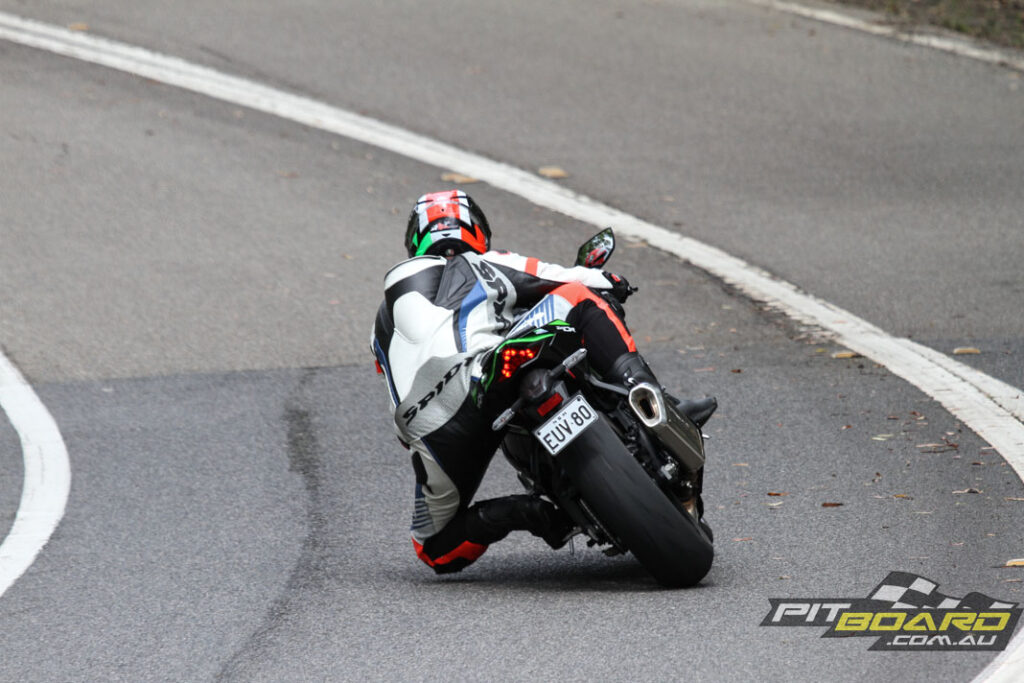
I head to the racetrack the next day in the hope of a good wet and dry test. Leaving home at sunrise and with a backpack of camera gear, I really appreciate the cruise control. I head to Sydney from the Coast on the M1, straight into the NorthConnex, down the M7 and arrive at SMSP having done 120km on cruise and feeling comfy and relaxed.
The only issue? It is absolutely pissing rain. Oh well, I have a job to do and as I always tell myself when I have to track test in the rain, I end up smiling most of the time anyway and keep going out for the fun of it. Like jumping in the surf, once the initial lap is out of the way (that first cold shock), it’s all good fun!
Now, Bridgestone RS11s are not exactly a rain tyre, however, where they have an advantage over some other supersport tyres is that they have grooves right to and off the edge, so my previous experience tells me they work to half lean, just off the shoulder, then crab predictably from there. Other tyres can dump you on your arse pretty quickly at that point! With that in mind, I set the beast to Rain mode and head out for a look around. Surprisingly, the grip is not too bad say for the mud washing over the track at turn five and the rubber on the apex of turn eight. It feels good so I stay out.
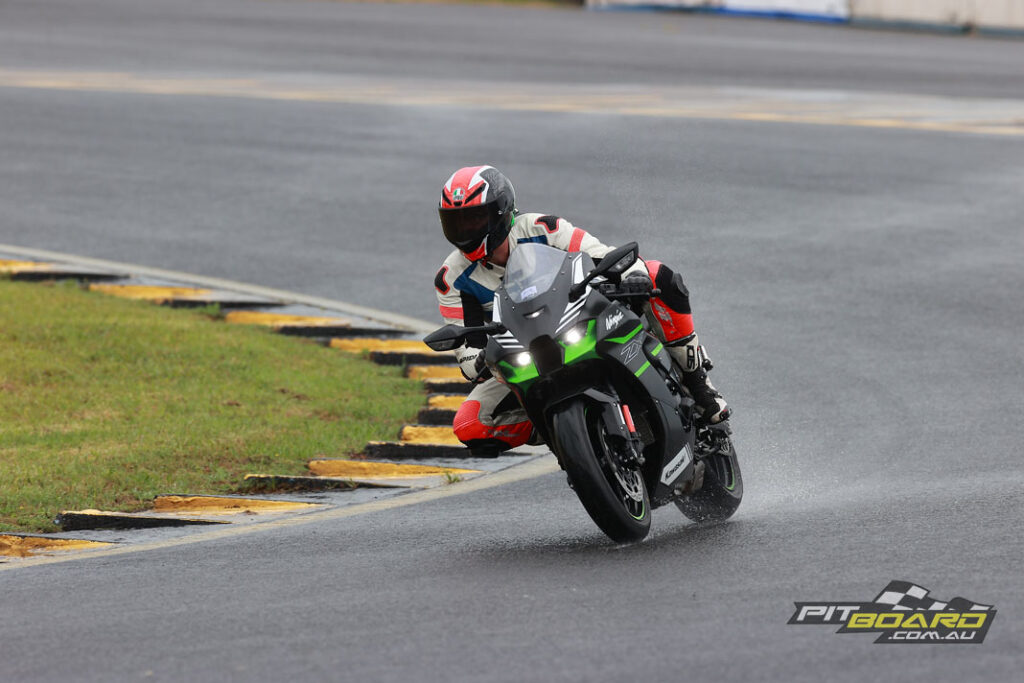
In Rain mode the power is dumbed down significantly and the throttle is soft, however, there is a snatch on initial opening that is not there in the other modes. Also, at constant throttle around 4000rpm, the engine suddenly steps up rapidly and there is a power spike. I ride around it and get used to the throttle and power, keeping the revs above 5000 where possible.
Even with traction maxed out, the rear RS11 tyre is spinning at certain points, particularly if I try and feed power in out of turn five, up the hill, it spins up significantly, the engine rapidly climbing revs, then the S-KTRC catches it before again, it spins up. This is a surprise as on the road in Rain or Road modes, when I buried the throttle hard the previous day, the S-KTRC would interfere quite a lot before any spinning would occur, so I am unsure why it is spinning up on the racetrack.
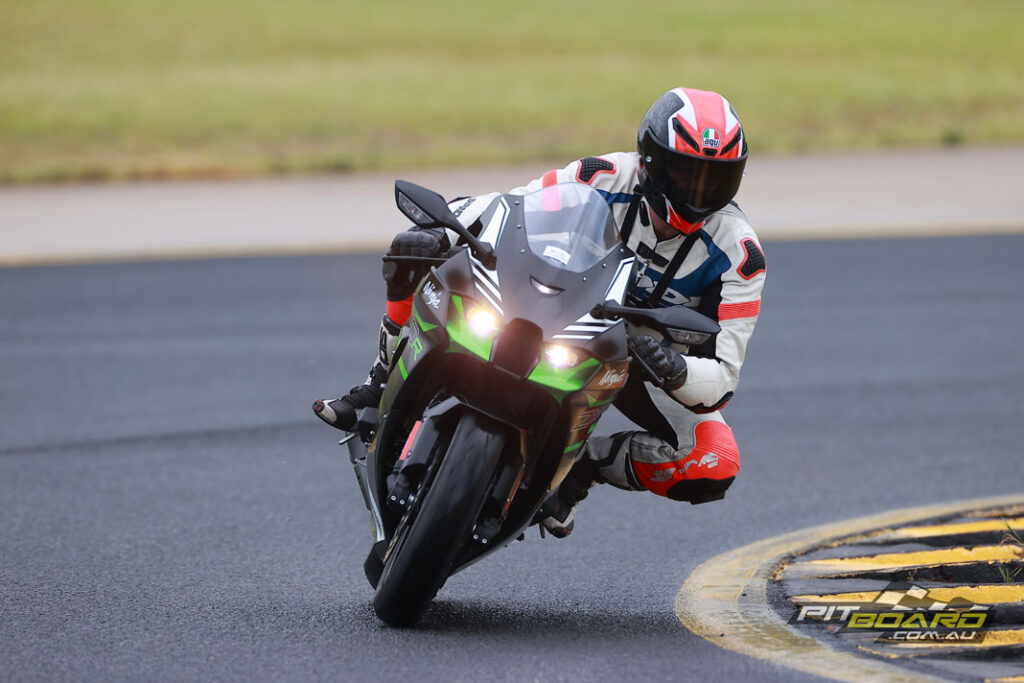
The braking package is impressive in these slick conditions and I’m thankful for the forgiving initial bite of the M50 calipers. Too often whopping 330mm rotors mean just breathing on a brake lever has your eyes popping out of their sockets. I much prefer to brake hard on my own terms, knowing the power is there the harder I squeeze, at least on a road based motorcycle and especially when negotiating a wet racetrack on road tyres.
Overall, after five sessions in the pouring rain, the ZX-10R got the job done and I am smiling as I roll out of the pits for the ride home. Of course, by the time I get to a coffee stop for a stretch, the sun is shining. Typical. I take the scenic route again, as if I wasn’t already mentally and physically drained. That’s just the engaging nature of the ZX-10R…
I’m blessed with a half sunny day a few days later, so gear up and head West to play with the custom Rider modes and get some more dry time on the bike. I end up having a good few hours of fun on Full power with S-KTRC off. The engine comes alive and is brutally strong. With 200hp on tap, you better hang on. It truly is a tyre shredding top-end only for those willing to play with fire.
The front wheel wants to hover above the ground in the first three gears above 8000rpm and the bike pulls out of corners like a missile. I then settle on Full power and S-KTRC level 2, which tames things a bit and makes me at least feel safer. On the other side of the performance spectrum, I set Rider mode 2 to Low power and maximum S-KTRC and try that on the slimy, damp parts of the road. It is super intrusive and safe, and a great option to have for those nasty sections or days.
The front wheel wants to hover above the ground in the first three gears above 8000rpm and the bike pulls out of corners like a missile…
Riding the bike back to KMA, I realised that the 10R can be a daily ride and a track day weapon. My initial impression of it being an all-out track bike was proven wrong by the simple fact that I used the 10R as a daily ride for almost two weeks and loved every minute. The little touches like the easy to get to sidestand, the great headlights, the loud horn, the taller screen, the awesome TFT display (although no range remaining is annoying), and the looks of the bike – it is stunning, with the River Mark and neat graphics, all add to the ownership experience. If I was younger, I’d have one as my daily ride. In fact, when I think of it, I did have a ZX-10R when I was 35…
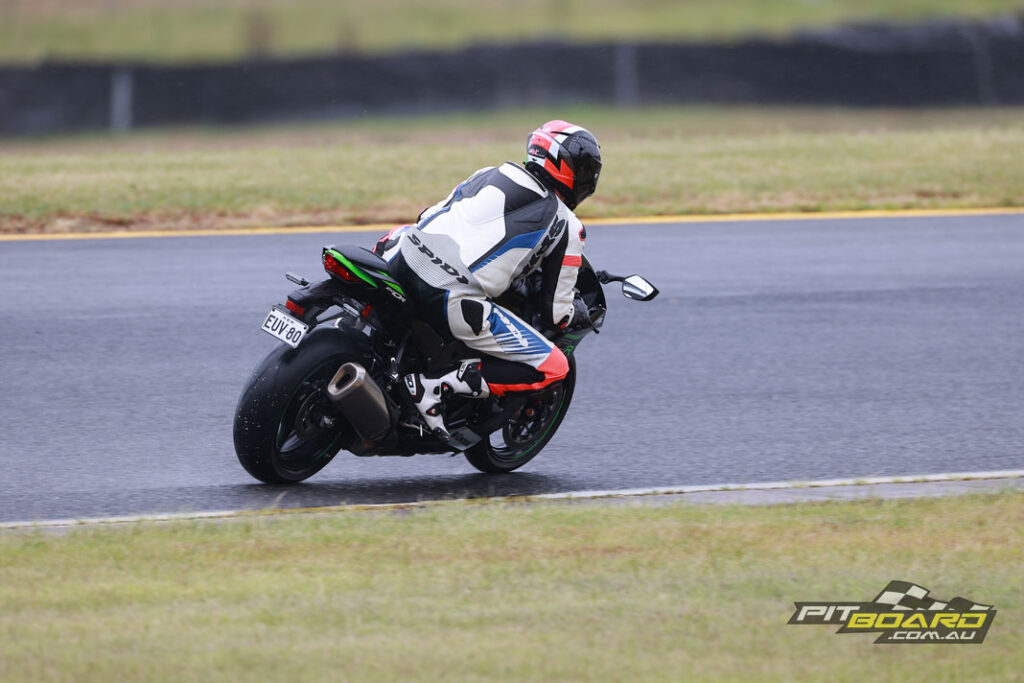
CONCLUSION
The new ZX-10R is more racebike than ever, with the same screamer yet tractable engine and a more track-focussed riding position and suspension setup. That makes it an even better ride day and road sports weapon than it was previously. The changes will take a small amount of comfort away on the road for taller riders but the handling improvements more than compensate for a little discomfort during those pesky transport sections. With the advanced electronics and high end brakes and suspension, and a price tag on par with the competition, it is well worth a look. Click here to find a Kawasaki dealership near you and go and have a try for yourself. Like I said, it looks even better in the flesh.
2021 ZX-10R Tech Highlights
The Ninja ZX-10R has won both riders’ and manufacturers’ titles for six consecutive years in WorldSBK, the pinnacle production road racing series. For the 2021 models, Kawasaki say that high level of track performance has been elevated yet further with new ZX-10R & ZX-10RR models.
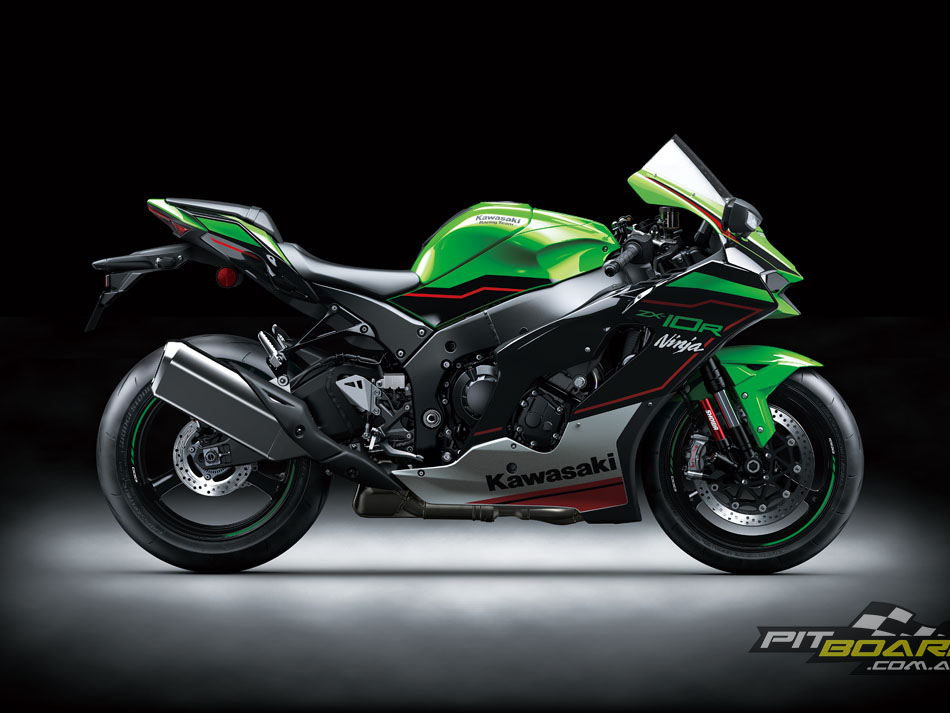
The 998 cm3, liquid-cooled, four-stroke, inline four, DOHC engine benefits from feedback based on the Superbike World Championship machine in the form of a new air-cooled oil cooler and cylinder-head changes, with both bikes high-lift cam ready. Peak power is 203hp with the race exhaust fitted, while the engine now meets the strict Euro 5 emissions requirements.
The new air-cooled oil cooler is a design often seen on high-performance models. Rather than routing coolant from the radiator to the oil cooler and back to the engine, the new oil cooler is air-cooled and has an independent circuit. Oil is routed from the left lower crankcase to the oil cooler, where it is cooled, then returned on the right side. The increased cooling performance contributes to engine performance at all rpm.
As for the limited-production Ninja ZX-10RR (500 machines worldwide), it benefits from new lightweight pistons to complement its Titanium connecting rods, both designed by Pankl. Also, a higher rev limit (400rpm more) further strengthens the potential of the base model. It also has Marchesini forged alloy wheels, a single seat and stainless-steel braided brake lines and an adjustable swingarm pivot point.
Designed with advanced aerodynamics, a new upper cowl with built-in winglets and compact headlights both improves aerodynamic performance and introduces next-generation Ninja styling. Furthermore, chassis geometry has been updated in order to improve upon the Ninja ZX-10R’s cornering performance and nimble handling. Suspension settings have been optimised to match. The swingarm pivot is 1mm lower, which enables better rear suspension action during corner exits.
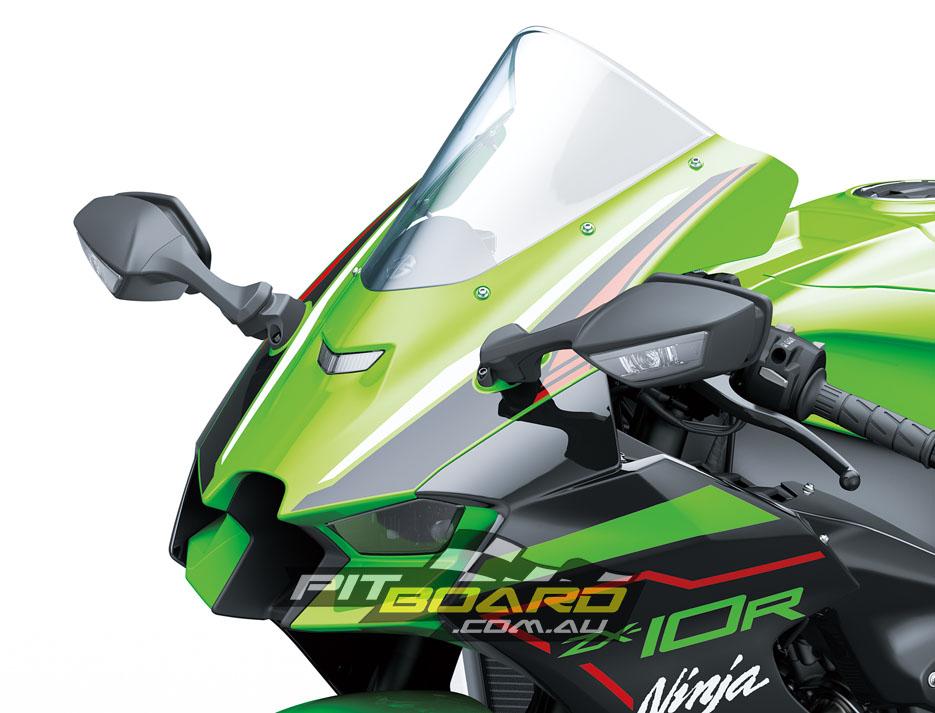
The screen is 40mm taller and set at a steeper angle. Together with the large upper cowl it contributes to the aerodynamic performance of the machine-rider package. The wind protection offered by the cowl and windshield translates to reduced stress from wind blast, enabling riders to change positions more smoothly as they set up for corner entry when riding on the track.
The LED headlights use direct projection units from Mitsubishi – the first use of their luminous optical modules on a motorcycle. The LED headlights are bright, compact and lightweight, weighing 1200g (compared to 1650g for the halogen units on the previous model). Use of a “reverse slant” design sees the new LED headlights positioned on the underside of the upper cowl. Flush fit of the centrally located LED position lamp contributes to the cowl’s aerodynamic performance.
The Ram Air intake – a Ninja supersport trademark – has a new shape and is more compact than that of the previous model, but the design of cowl directs air toward the intake so its efficiency is unchanged. Winglets built into the upper cowl generate downforce that helps keep the front wheel on the ground on corner exits and during strong acceleration. Openings in the side cowl help dissipate engine heat, directing hot engine air away from the rider’s knees. Cowl-mounted mirrors feature new-design integrated LED-type (1-bulb) turn signals.
Wider fork clamping area for the lower triple-clamp and revised rigidity balance for the fork outer tubes contribute to improved handling and turning performance. Revised handle position is 10mm farther forward with less turn-in (i.e. straighter), contributing to a more aggressive, circuit-focused riding position.
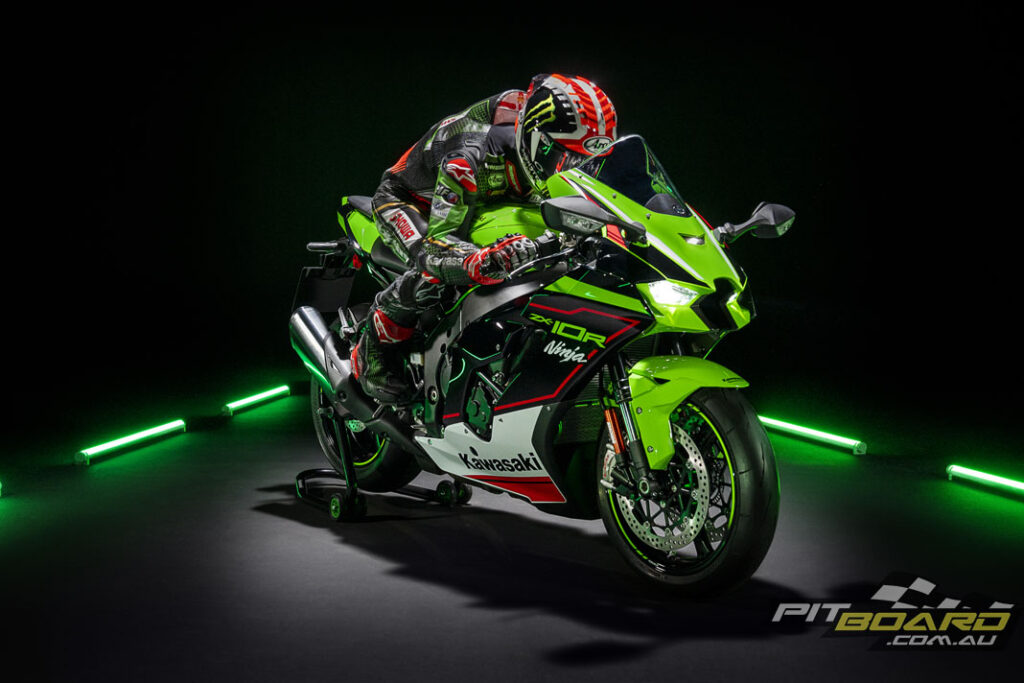
A longer wheelbase (1440mm to 1450mm) care of a 2mm greater fork offset and an 8mm longer swingarm offers even greater overall stability – already a strength of the previous model. The revised fork offset results in a shorter trail, which facilitates changing direction, especially in the off-throttle phase of the corner (after tip-in, before apex). The new geometry moves the front-rear balance slightly forward (0.2%), contributing to improved handling and turning performance.
More circuit-focused settings include a stiffer spring rate (91 N/mm >> 95 N/mm), complemented by softer compression damping, and softer rebound damping. The revised settings make it easier to induce pitching motion even when on the throttle while maintaining the rear height steady.
At the back, more circuit-focused settings include a stiffer spring rate (91 N/mm >> 95 N/mm), complemented by softer compression damping, and softer rebound damping. The revised settings make it easier to induce pitching motion even when on the throttle while maintaining the rear height steady.
Repositioning the rear brake reservoir further to the inside offers riders greater freedom of movement as they shift position on the bike. Footpegs are positioned 5mm higher, contributing to the more aggressive, circuit-focused riding position. The higher position makes it easier to weight the pegs when cornering. The rear of the rider’s seat is higher, allowing riders to elevate their hips when in a full race crouch. The position makes it easier to minimise drag when tucked in.
Finally, the addition of new features like Electronic Cruise Control and TFT colour instrumentation with smartphone connectivity makes it possible to enjoy sport riding in a wider range of situations. Riders can choose from three pre-determined settings (Sport, Road, Rain) or four manual settings (Rider 1-4). In the manual Rider modes, each of the systems can be set independently.
High-grade full colour display features TFT (thin-film transistor) technology, delivering a high level of visibility. The screen’s background colour is selectable (black or white), and screen brightness adjusts automatically to suit available light.
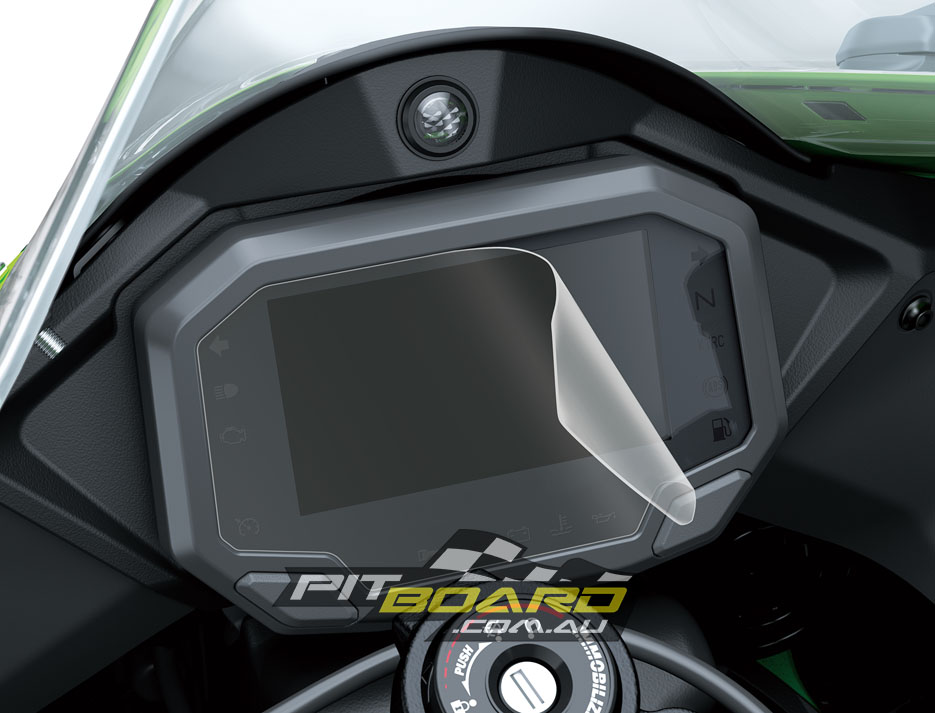
Updates to Modes 4 and 5 (the most intrusive) result in a more rider friendly character that facilitates making throttle inputs mid-corner or on corner exits. The benefits can be noticed when cornering on the circuit or on winding roads. In addition to scrollable multifunction windows, two display modes offer riders a choice of how their information is presented.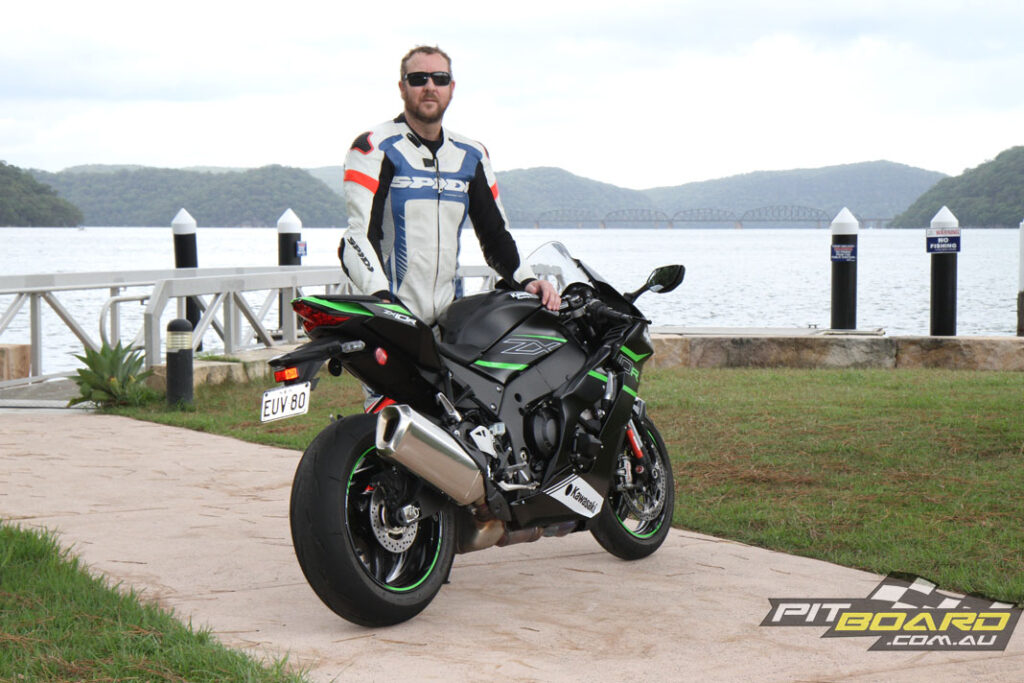
2021 Kawasaki Ninja ZX-10R Specifications
Price: From $26,000 + ORC ($28,117 Ride Away, Sydney See Kawasaki website for on-road cost at your postcode (link)
Click ‘How Much?’ tab to get your personalised On-Road cost (includes CTP, rego etc)
Warranty: Two-year, unlimited kilometre
Colours: (Tested) Lime Green with Ebony & Pearl Blizzard White – Kawasaki Racing Team (GN1), Flat Ebony – Kawasaki Racing Team (BK2)
Service: 1k then every 12k, valve clearance & spark plugs every 24k
Claimed power: 149.3kW[203hp]@13200rpm (213hp with ram air)
Claimed torque: 114.9Nm[85ft-lbs]11400rpm
Wet weight: 207kg
Fuel consumption (measured over 500km): 6.2L/100km
Fuel capacity: 17L
Engine: Liquid-cooled, in-line four-cylinder, four-stroke, 16-valve, DOHC, 998cc, 13.0:1 compression, 76 x 55mm bore x stroke, four dual injection 47mm injectors, electronic throttle valves, S-KTRC, Ride Modes, KEBC, KLCM, KQS Gearbox: Six speed, cassette style Clutch: Wet, multi-disc back-torque limiting clutch.
Chassis: Cast aluminium twin spar frame, aluminium swingarm, Rake: 25, Trail: 106.7mm
Suspension: 43mm Showa BFF forks, external compression chamber, compression, rebound, preload adjustable, 120mm travel, Showa BFRC lite shock, compression, rebound, preload adjustable, horizontal Back-link, 115mm travel.
Brakes: (KIBS) Dual 330mm semi-floating Brembo front rotors, Brembo radial Monobloc four-piston M50 calipers, Brembo master-cylinder, 220mm rear rotor, Nissin single-bore pin-slide caliper
Wheels & Tyres: Gravity cast 3-spoke, 120/70 – 17, 190/55 – 17 Bridgestone RS11 Battlax Racing Street tyres, Ohlins electronic steering damper,
DIMENSIONS:
Wheelbase: 1450mm
Ground clearance: 135mm
Seat height: 835mm
Overall length: 2085mm
Overall width: 750mm
Overall height: 1185mm
Instruments & Equipment: 4.3in TFT display, Power Modes, S-KTRC (Sport Kawasaki TRaction Control), KQS (Kawasaki Quick Shifter), 6 axis IMU, KCMF (Kawasaki Cornering Management Function), electronic steering damper, (ECC) Cruise Control, (ERI) Economical Riding Indicator, KIBS (Kawasaki Intelligent Braking System), KLCM (Kawasaki Launch Control), EBC (Engine Brake Control), BT connectivity via RIDEOLOGY THE APP.
2021 Kawasaki ZX-10R Gallery


